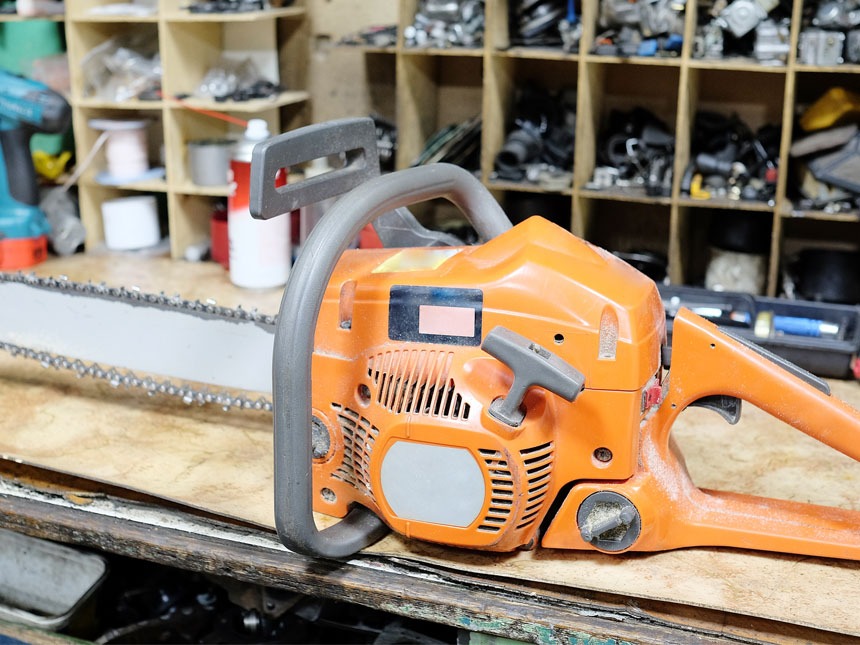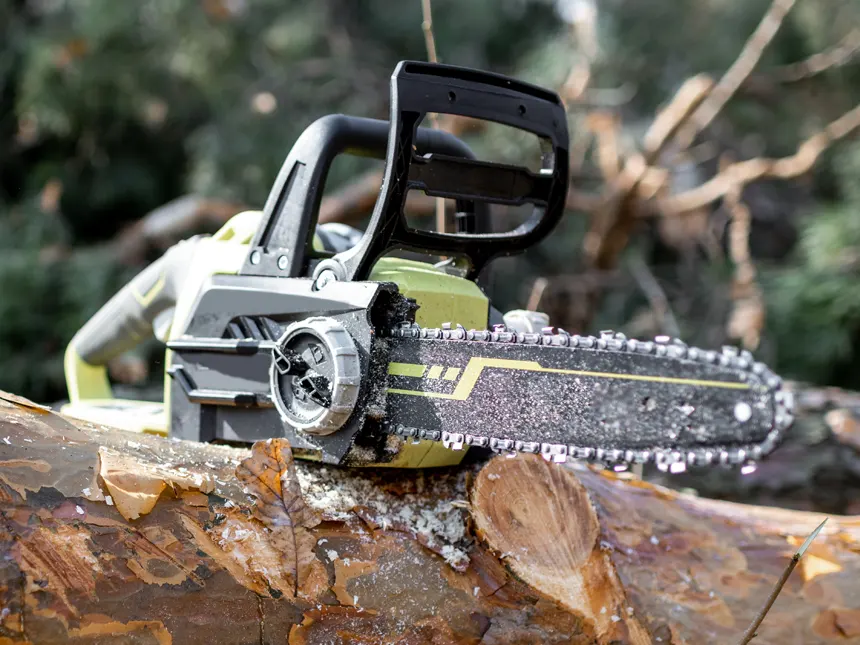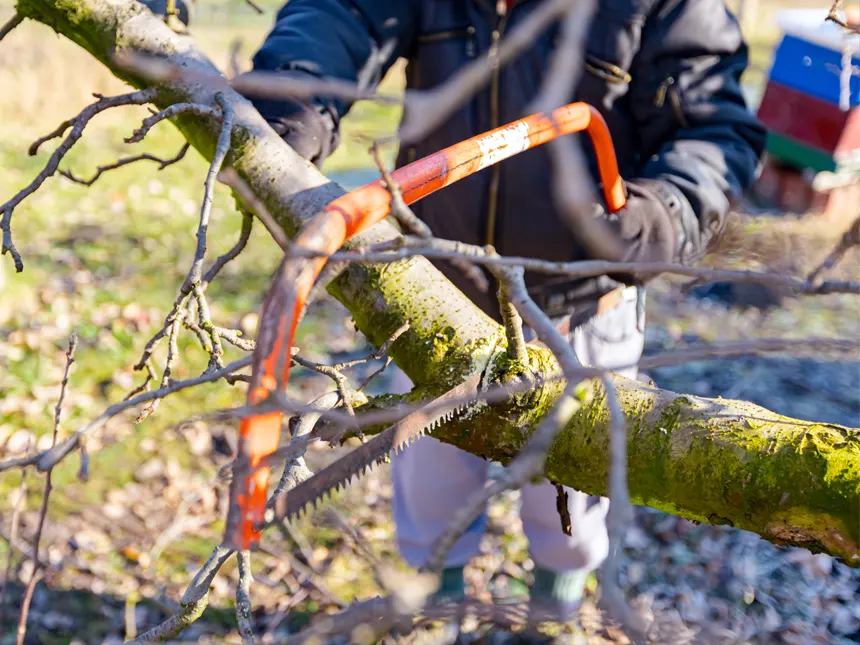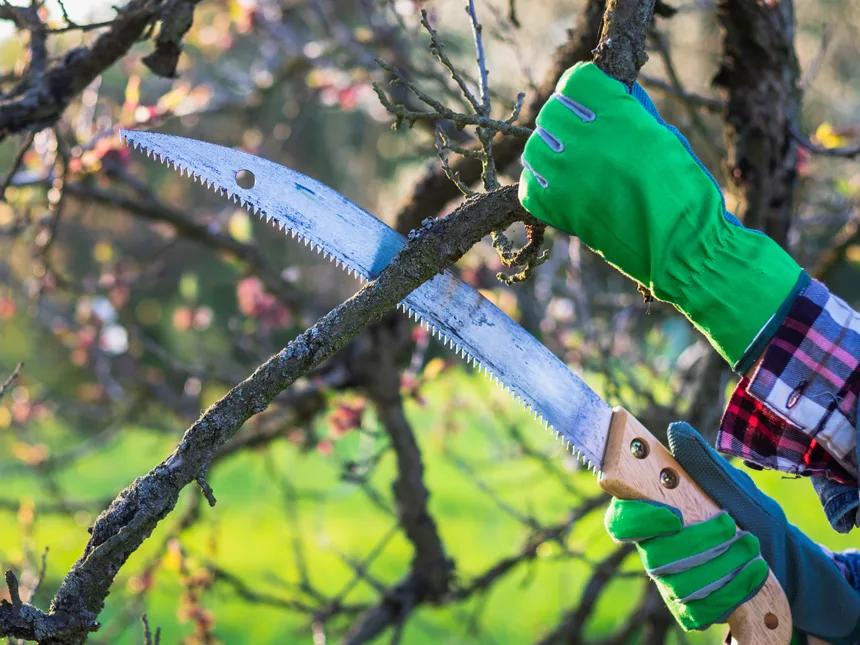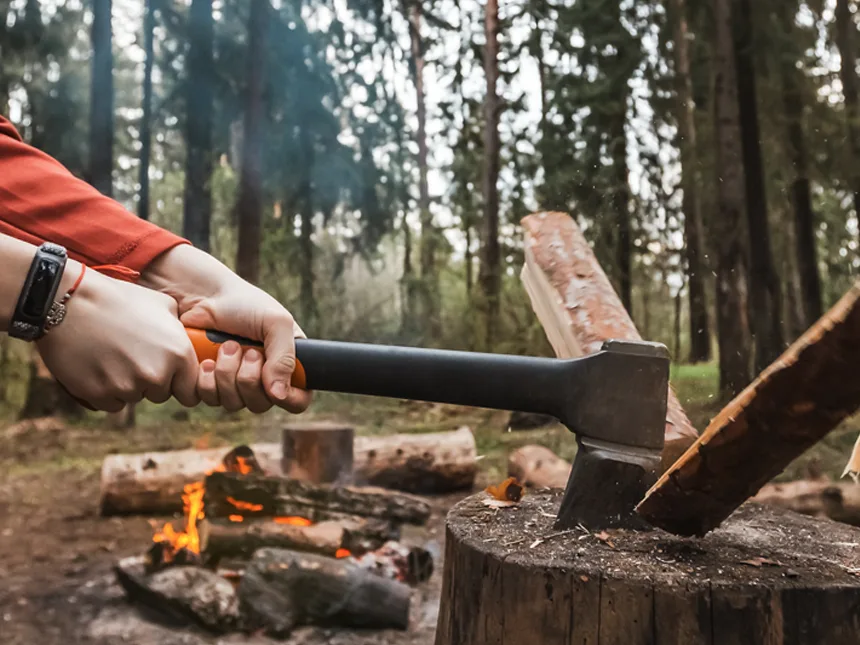Tomahawk vs Hatchet: What’s the Difference?
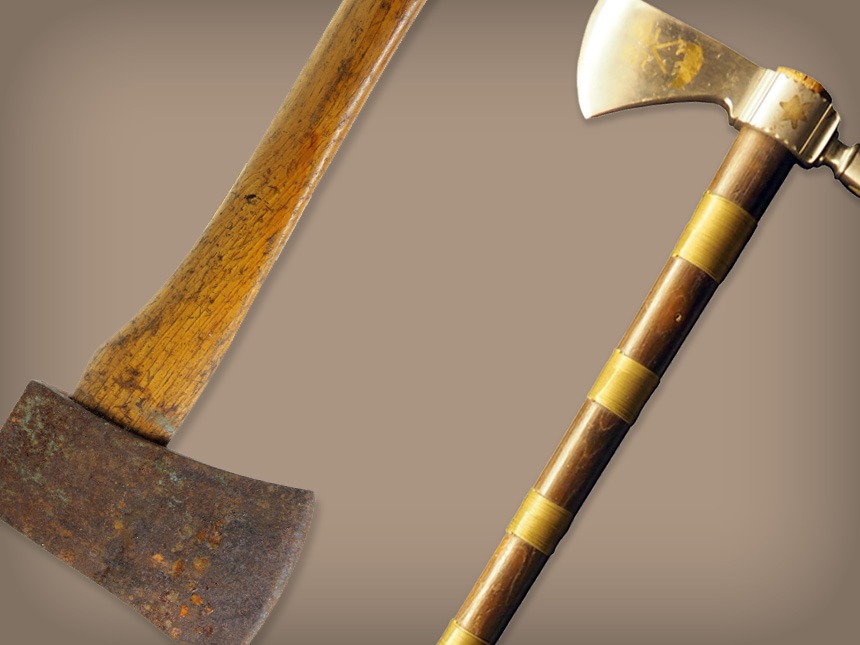
Timber Gadgets is reader-supported. We may earn a commission if you buy through the links on our site.
Tomahawks and hatchets are terms that are often thrown around interchangeably. But in reality, the tools themselves are strikingly different and, depending on the task, couldn’t be switched out. Tomahawks and hatchets have distinctive appearances and uses.
A tomahawk is a longer tool with a severely tapered head and bit, used primarily for chopping, throwing, and self-defense. A hatchet is a small, compact tool with a noticeable but less drastic taper between the hammer and bit. It’s used primarily for chopping and field work.
Hatchets are half the size of tomahawks but often heavier, with the weight less evenly balanced and distributed towards the head. Tomahawks can be further identified by their more “streamlined” head design, which features holes in the steel to reduce weight.
Tomahawks and hatchets are both popular tools with a variety of uses, though which one is best for you depends on what you’ll be using it for. Tomahawks have a wider array of uses, but hatchets are far superior at the fewer tasks they’re made for.
Keep reading to learn more about their similarities, differences, and which is right for you.
Table of Contents
Tomahawks
Let’s quickly go over the appearance of a tomahawk as well as what its used for!
Appearance
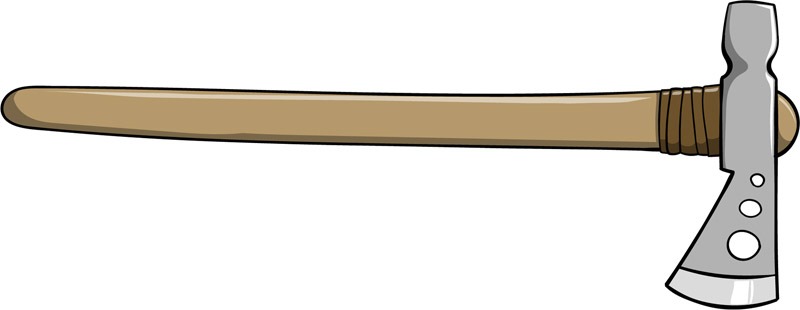
Tomahawks have thin heads that are lightweight and usually detachable. To reduce weight without also sacrificing effectiveness, they have one or two circles cut out of the middle of the head. This doesn’t affect the bit’s power or ability to cut, but does remove the added weight of the steel.
The bit is at least four inches long, but not significantly more so. There’s usually a spike or hammer at the opposite end of the end, although other tools have also been incorporated over the years.
Between the bit at one end and the spike at the other, the head has a severe taper that forms a loose triangle shape.
The shafts are short (no more than 24 inches at most), perfectly straight, and also designed to make the tool as light as possible.
Usage
When it comes to woodworking, tomahawks are ideal for small to medium tasks. This includes:
- Chopping pieces of firewood
- Cutting down saplings and small trees
- Removing small tree limbs
- Cutting back bushes and other foliage
The tomahawk’s longer shaft provides more leverage for cutting. However, this is slightly undercut (pun intended) by the head’s flatness. The flat sides throw wood chips less efficiently and make it more like that the tomahawk will become stuck in the wood.
However, this can be mitigated if you specifically search for a tomahawk with more convex sides. Though rare, they could be fabricated.
It’s more likely you’ll see them being used for throwing and other recreational purposes. If you go to an axe-throwing range, chances are you may end up handing tomahawks.
They’re constructed to be well-balanced and feel like a natural extension of your arm, making them a perfect choice for these activities.
Less common but still effective is the tomahawk’s use as a self-defense and close combat tool. Though it’s no longer a common sight to watch people fend off burglars and bears with them, tomahawks have a long-standing tradition of being used for protection.
It’s from these roots that the tomahawk’s name is actually derived. ‘Tomahawk’ comes from the Native American word ‘tomahac,’ which Europeans adapted along with the tool itself. The materials shifted from stone to steel and the design was adapted to make it lighter and more balanced.
In case you’re ever put in this position or want to create a customized shaft, tomahawks are also easier to haft. They can be hafted from the bottom, while axes and hatchets usually need to be hafted starting at the top.
Hatchet
It’s easy to distinguish a hatchet from a tomahawk once you know the differences! Lets go over the appearance of a hatchet then look at what they’re used for. By the watch, a hatchet has many of the same parts as a full-length axe. You can learn more about the parts of an axe on his website.
Appearance
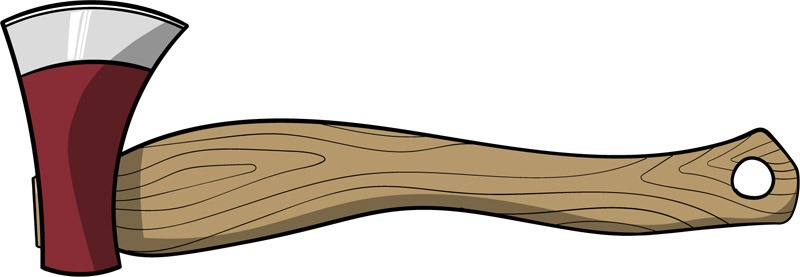
Hatchets are one of smallest variants of axes and cutting tools. They are much smaller than tomahawks in terms of length, girth, and overall size.
They’re closer in size and weight to a hammer than an axe. Also like a hammer, hatchets comfortably fit in and are meant to be used one-handed.
And hatchets often have a hammer head on the opposite side of the bit. Obviously, the bit is the most well-used part and necessary for cutting and chopping. But the hammer head is used for striking, which comes in handy for yardwork and camping, as we’ll discuss a bit later.
However, this is where the similarities end. Whereas hammer heads meet the shaft at a 90-degree angle, hatchet shafts tend to curve. This places the head closer to the forward-most point of the handle’s lowest part.
Hatchet heads are usually narrow and have a taper, created by a small body and large bit. Though less drastic than the taper on a tomahawk, the taper is still noticeable.
Depending on what you’ll be using it for, you could forgo the hammer head and instead opt for a double-bit hatchet, which has sharp edges on both sides of the head.
The hatchet bit and head is made of metal, usually steel. Traditionally, these are connected to a wooden shaft. However, there hatchets available that are completely made of steel and just have a rubber or foam grip.
Usage
Because of their size, hatchets aren’t appropriate for large-scale work. Instead, they’re best suited for smaller woodworking projects, such as:
- Cutting down saplings and small trees
- Cutting back bushes and other foliage
- Removing small tree limbs
But don’t discount the hatchet because of its size and limited capability— in fact, its size is actually what makes it so attractive to many people.
They’re smaller, which also means they’re more maneuverable, easier to handle, and require less energy to use.
If you just need a tool around the backyard, the hatchet is perfect. Almost anyone can use them, even people who are younger, older, or have limited movement.
Hatchets are also a popular choice for people who camp often. Though hand axes are the preferred tool for this activity (hence their nickname of ‘camping axe’), hatchets have grown increasingly common.
They’re ideal for splitting pieces of firewood and chopping kindling, building a simple shelter or lean-to, or hammering in tent stakes. You can even break down small game with them and chop through built-up snow and ice.
This takes care of three basic survival needs: warmth, shelter, and food. Because of this, they’re also ideal to keep in your house or primary residence as an emergency tool.
How To Tell The Difference
You may have already guessed this, but one of the main differences between a tomahawk and a hatchet is what you can do with them.
Tomahawks are fairly versatile. In addition to the uses we’ve already listed for tomahawks, you can also use a tomahawk to do almost everything a hatchet can do. That is, you can use a tomahawk for cutting, throwing, and combat and self-defense.
On the other hand, a hatchet is more limited; you can’t really use a hatchet to do the same things as a tomahawk. While it’s great at cutting and can be used for self-defense, it’s certainly not suited for throwing or combat.
But there are other, more immediately noticeable differences that are useful to know, too. So if you’re looking at a tool in store or online and need to know if it’s a tomahawk (or a hatchet, or neither), here’s a quick list of what to check for:
- Head – Tomahawk heads have a bit and stake (or pipe, etc) on opposite ends, forming a severe triangle shape; hatchets have a bit and a hammer (or poll), creating a less drastic taper.
- Bit – Tomahawks have a thinner and often longer bit, with straight ‘cheeks’; hatchets are a wider but shorter bit with concave ‘cheeks.’
- Shaft – Tomahawks have a straight, long handles that make them ideal for combat and throwing; hatchets are short and stout, with curved shafts half the size of a tomahawk’s.
- Weight – Despite being longer, tomahawks will be lighter than hatchets; hatchets are small but surprisingly sturdy and hefty.
After reviewing these characteristics, you should be able to easily tell if what you’re looking at is a hatchet or a tomahawk. Whether or not it’s labelled correctly will also give you an idea of the seller’s legitimacy.
If you notice that the tool in question doesn’t match any of the characteristics listed above, you may be looking at a different type of axe entirely. There are more than a dozen types of axes and cutting tools, each with their own uses and characteristics.
Before You Buy A Tomahawk Or Hatchet
Don’t rush into buying a tomahawk or hatchet. Think about what you’ll be using the tool for, and then decide which would better suit you.
If you’re looking for a versatile tool that can serve you well in a number of different settings, from work in the backyard to camping to recreational fun, then tomahawks may be better suited for you. And if you appreciate modern or streamlined aesthetics, the tomahawk can also fill those needs.
But if you’re looking for a more classic tool to work around the house or in the woods, a hatch will probably do just fine. Though certainly less fancy-looking than a tomahawk, it’s superior in terms of cutting wood.
You should also critically think about who’s going to be handling the tool. What are their physical capabilities (or limitations) and range of movement? The tomahawk is lighter, but the hatchet is more maneuverable and easier to hold.
Safety is another key issue to think about. Both are dangerous tools and should be handled with extreme caution. However, a hatchet could present more risk because it’s weight is not evenly distributed.
Take this scenario for example: a person is trying to chop a piece of firewood in front of them. They accidentally miss and the tool slips from their hands. A tomahawk would likely continue straight and bury itself into the ground. But because a hatchet is top-heavy, it could curve and hit that person’s legs.
Conversely, some people may find the tomahawk more likely to be dangerous in this scenario. A tomahawk’s straight handle makes it easier to slip from a person’s hands, whereas the hatchet’s curved handle is deliberately designed to enhance grip.
Even after you decide whether a tomahawk or a hatchet is the right tool, your work still isn’t done. Before you buy, consider these factors:
- Blade Shape – A blade’s shape will determine how much contact and penetration it achieves. Flatter blades provide more contact, while curved blades provide more penetration. Think about which would suit you best; if you’re unsure, go with a slightly curved blade, which provides more versatility.
- Thickness – Examine how thick the shaft is and consider whether it would fit in your hands well. Shafts that are too thin in diameter can be uncomfortable, as can shafts that are too thick.
- Weight – If you’re in the store and able to pick up the tool, do so. Feel how it fits in your hands and see if the weight is evenly distributed. Move around with it and think about how easily you could swing and chop with it.
Finally, make sure you’re looking at reputable sellers with quality products. Buying the cheapest hatchet available may save you money in the short-term, but you’ll have to replace it more quickly.
It could also become a safety liability if your tool breaks as a result of poor craftmanship.
More than likely, there are in-depth reviews and videos online that will give you a better idea of how the tomahawk or hatchet will handle. You’ll also be able to see users’ most common complaints and decide if those are breaking points for you.
Depending on how specific your needs are, you may even be able to email the company or manufacturer to ask if their product is suitable.
If they respond, you should consider them the foremost experts. Even if there is a common consensus among users that a hatchet can be used for XYZ purpose, that doesn’t mean that’s designed or safe to be used in this way.
Do your research and make sure to buy a hatchet or tomahawk with excellent reviews and a proven track record of dependability and longevity. Should you decide to go with a hatchet, I suggest looking at our best hatchet buyer’s guide.

